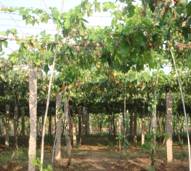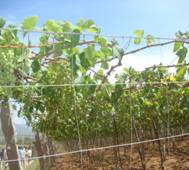Grapes (Vitis vinifera)
Vitaceae
Varieties:
Muscat (Panneer), Pachadraksha, Anab-e-Shahi, Thompson Seedless, Arka Shyam, Arka Kanchan, Arka Hans, Manik Chaman, Sonaka, Sharadh Seedless and Flame Seedless are normally cultivated.
Muscat is grown in Tamil Nadu where the rainfall is low to moderate. |
|
Soil and climate
The crop performs best in well-drained rich loamy soil with a pH of 6.5 - 7.0 with low water table with EC less than 1.0. Soil depth should be at least 1 m.
Field preparation and planting
Trenches of 0.6 m width and 0.6 m depth are to be dug at a distance of 3 m apart for Muscat and pits of 1m x 1m x 1m should be dug for other varieties. Well-decomposed FYM or compost or green leaf manure has to be applied in the trenches or pits as the case may be and then covered with soil. Plant the rooted cuttings in June-July.
Spacing
The adopted spacing is 3 x 2 m for Muscat and 4 x 3 m for other varieties.
Irrigation
Irrigate immediately after planting and on the 3rd day and then once in a week. Withhold irrigation 15 days before pruning and also 15 days before harvest.
Manures and fertilizers (Kg per vine)
VARIETY |
FYM |
GREEN LEAVES |
N |
P |
K |
| I |
II |
III |
I |
II |
III |
I |
II |
III |
I |
II |
III |
I |
II |
III |
| Muscat |
50 |
50 |
100 |
50 |
50 |
100 |
0.10 |
0.20 |
0.20 |
0.08 |
0.16 |
0.16 |
0.30 |
0.40 |
0.60 |
| Pachadraksha Thompson seedless |
50 |
50 |
100 |
50 |
50 |
100 |
0.20 |
0.30 |
0.40 |
0.08 |
0.16 |
0.24 |
0.40 |
0.80 |
1.20 |
Sonaka, Manikchaman
Sharad seedless, Anab-e-Shahi |
50 |
50 |
100 |
50 |
50 |
100 |
0.20 |
0.40 |
0.60 |
0.08 |
0.16 |
0.24 |
0.40 |
0.80 |
1.20 |
The manures should be applied twice after pruning. Apply half the dose of potash immediately after pruning and the other half after 60 days of pruning.
Foliar spray of 0.1% Boric acid + 0.2% ZnSO4 + 1.0% Urea twice before flowering and 10 days after first spray should be done to overcome nutrient deficiency.
Training
The vines are trained with single stem upto pandal with a stalk on tipping at 2 m height. The main arms are developed and trained on opposite directions. On further tipping, secondary and tertiary arms are developed for spreading all over pandal.
 
Pandal system of grape growing
Pruning
In general four bud level of pruning for Muscat, Pachadraksha, Bangalore Blue, Anab-e-Shahi and Arka hybrids and two bud level for Thompson Seedless may be adopted. It is better to decide the level of pruning as per bud forecasting technique. Weak and immature canes should be pruned to one or two buds to induce vegetative growth.
Pruning Season
Summer crop
Pruning is done in December – January and harvesting in April – May.
Monsoon crop
Pruning is done in May-June and harvesting in August-September.
Special practices
Tipping of shoots and tying of clusters in the pandal after the fruit set should be done. The tendrils have to be removed. Nip the growing shoots of axillary buds and terminal buds at 12 to 15 buds. Fruit thinning is done in compact bunches by removing 20 % of the berries at pea stage.
Dip the clusters in solution containing Brassinosteroid 0.5 ppm and GA3 25 ppm at 10-12 days after fruit set to maintain vigour, yield and quality parameters.
Plant protection
Pests
Nematodes
60 g of Carbofuran 3 G or Phorate 10 G granules per vine are applied a week before pruning and the plots are irrigated profusely. The soil should not be disturbed for atleast 15 days. Thereafter normal manuring may be done. Application of neemcake 200 g/vine also controls nematodes. Alternatively, application of Pseudomonas fluorescens formulation in talc containing 15 x 108 colony forming units/g, 30 cm away from base of the vine at least 15 cm depth at the time of pruning will also serve as a control measure.
Flea beetles
Spray Phosalone 35 EC (2ml/lit of water) after pruning and followed by two or three sprayings. The loose bark may be removed at the time of pruning to prevent egg laying.
Thrips
Spray Methyl demeton 25 EC or Dimethoate 30 EC @ 2 ml/lit of water to control thrips.
Mealy bug
Apply Quinalphos or Methyl parathion dust in the soil @ 20 kg/ha to kill the Phoretic ants. Spray Methyl demeton 25 EC or Monocrotophos 36 WSC @ 2 ml/lit of water or spray Dichlorvos 76 WSC @ 1 ml/lit with fish oil resin soap at 25 g/lit to control the pest. Release Coccinellid beetle, Cryptolaemus montrouzieri at the rate of 10 per vine.
Stem girdler
Swab the trunk with Carbaryl 50 WP @ 2 gm/lit to control the pest.
Diseases
Powdery mildew
Spray 0.3% Wettable sulphur or dust Sulphur @ 6-12 Kg/ha in the morning hours to control the fungus.
Anthracnose
Spray 1 % Bordeaux mixture or any other copper fungicide at 0.25 % concentration. Depending upon the weather conditions the number of sprays has to be increased.
Downy mildew
Spray 1 % Bordeaux mixture or any other copper fungicide at 0.25 % concentration. Depending upon the weather conditions the number of sprays has to be increased.
Ripening
To get uniform ripening in Muscat, spray the bunches with 0.2% Potassium sulphate (2 g/lit) at 20th day after berry set and another spray on 40th day.
Dip the clusters of Thompson seedless and other seedless varieties at calyptra fall stage with 25 ppm GA (25 mg/lit) and repeat again at pepper stage to increase the length of berries.
Yield
Seedless : 15 t/ha/year
Muscat : 30 t/ha/year
Pachadraksha : 40 t/ha/year
Anab-e-Shahi and Arka hybrids : 20 t/ha/year
Preparation of 1% Bordeaux mixture
A quantity of 400 g of Copper sulphate should be dissolved in 20 lit of water and 400 g of lime in another 20 lit of water separately. The copper sulphate solution should be added to the lime solution by constant stirring of the mixture. Earthern or wooden vessels and plastic containers alone should be used and metallic containers should not be used. To find out whether the mixture is in correct proportion, a polished knife should be dipped in the mixture for one minute and taken out. If there is reddish brown deposit of copper, additional quantity of lime should be added till there is no deposit in the knife. |
Safe waiting period
A period five days for Dimethoate and Carbaryl. |



